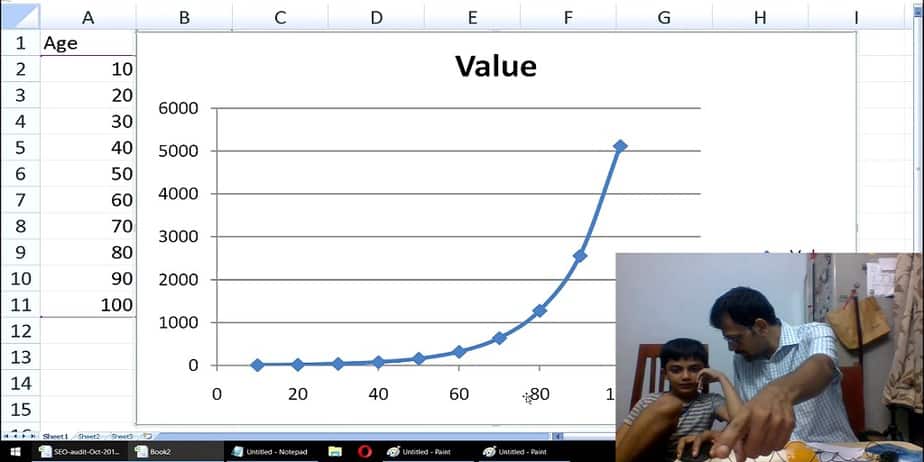Last Updated on December 29, 2021 at 11:57 am
I discuss how the power of compounding can be explained to children with an example. The video of an experiment with my 8Y old son is also included. For children under ten, the essential point to be conveyed is that if we do not touch the money invested and let it grow and give it enough time, it will grow into something unimaginably big and that is the power of compounding. For slightly older children, we can emphasise the point that for each year, both the amount that we put in and also the profit that we get from it each year grow at the same pace. The huge final amount is mainly from the growth of the profit.
I strongly believe that we can teach any concept to children who can understand sentences. If they do not understand it is only because we have not understood it ourselves deeply enough. I also believe we should push children and ourselves to learn/teach ideas that are well above their age if we go by their school syllabus as long as they have the willingness to listen. So if your children (esp. mine) did not understand the following example. it is only because that I need to improve my understanding of compounding and provide better ones. They may not get everything that you have to say. That is not the idea. A little half-spark here and there in their minds is enough to compound into something big (pun intended).
Teaching kids the power of compounding
The following is written as if I am discussing with a child. Suppose I give you ten rupees at the age of ten (when you were 10 or will reach 10, as the case may be). If you did not touch that money for ten years, I will double the amount. So by age 20, you will have Rs. 20. If you did not touch this Rs 20, I will double it when you are 30 years of age and so on. So let us now draw a table between your age and the amount of money that you will have.
Join 32,000+ readers and get free money management solutions delivered to your inbox! Subscribe to get posts via email! (Link takes you to our email sign-up form)
🔥Want to create a complete financial plan? Learn goal-based investing? Exclusive access to our DIY tools? Increase your income with your skills? Use this link to enjoy massive discounts on our robo-advisory tool & courses! 🔥
| Age | Value |
| 10 | 10 |
| 20 | 20 |
| 30 | 40 |
| 40 | 80 |
| 50 | 160 |
| 60 | 320 |
| 70 | 640 |
| 80 | 1280 |
| 90 | 2560 |
| 100 | 5120 |
Now notice that Rs. 10 grew to Rs. 5120 over the next 90 years. That is a 500 times increase and most people could never guess that the growth can be this much. This is known as the power of compounding. So if we plot your age versus the money that you will have, we get.
Notice that if you look at the value at age 100, the value up to age 40 looks almost flat. That is like it did not grow at all and then it zooms up. This effect is referred to as the power of compounding. We will see below how this comes because of the huge increase in profit every ten years. So our job now is to understand this growth.
Note to parent: I can think of two ways to do this. I am sure that there are other simpler ways (eg. people use the doubling of grains in each square of the chess board). In fact, the first explanation below is related to the chessboard analogy
Power of compounding: Explanation 1
- At age 10, you have Rs. 10.
- At age 20, the ten you had doubles. So you have 20. This is 10 + 10. The first 10 is what you originally had and the next 10 is the profit from the investment of 10 years.
- At age 30, this 20 doubles to 40. So this can be written as 20 + 20. Now the 10 + 10 you have above becomes 20 + 20.
- Age 40, the 40 doubles to 80. So 20 + 20 ==> becomes 40 + 40.
- Please write down similar rules for ages 50, 60, 70 80, and 90.
| Age | Value |
| 10 | 10 |
| 20 | 10 + 10 |
| 30 | 20 +20 |
| 40 | 40 + 40 |
| 50 | 80 + 80 |
| 60 | 160 + 160 |
| 70 | 320 + 320 |
| 80 | 640 + 640 |
| 90 | 1280 + 2180 |
| 100 | 2560 + 2560 |
We can rewrite this as
| Age | Value |
| 10 | (10) |
| 20 | (10 + 10) |
| 30 | (10 + 10) + (10 + 10) |
| 40 | (10 + 10) + (10 + 10) + (10 + 10) + (10 + 10) |
| 50 | and so on … |
| 60 | |
| 70 | |
| 80 | |
| 90 | |
| 100 |
You see the doubling of the original amount more clearly this way. Note to parent: Now this resembles the chessboard problem. The above is more like a math lesson. I wanted to teach my son a life lesson: let the money grow undisturbed for as long as possible and the profits will compound into something astonishingly large.
Power of compounding: Explanation 2
This is the one I tried to teach my son in the video below.
- At age 10, you have Rs. 10 (we will denote this original Rs. 10 in red for reference)
- Age 20, you still have the original Rs. 10 + a profit of Rs. 10 (from the doubling). So 10 + 10
- At age 30, you still have original Rs. 10 + a profit of Rs. 10 from this + the profit that you got at age 20 doubles to 20. So it is 10 + 10 + 20 = 40 = 10 + 30. The total profit is now Rs. 30.
- At age 40, you still have original Rs. 10 + a profit of Rs. 10 from this + the total profit that you got at age 30 doubles to 60. So it is 10 + 10 + 60 = 80 = 10 + 70
- At age 50, it is 10 + 10 + 140 = 160 = 10 + 150 . The 140 comes from doubling of the 70 (total profit at age 40)
Note to parent: Yeah, yeah I know what you are thinking, that it is a bit much. Please do not assume your child will not understand what you don’t.
| Age | Amount Invested | Profit from the original amount | Profit from doubling of previous years total profit | Total Profit | Total Value = tot profit +amt |
| 10 | 10 | 10 | |||
| 20 | 10 | 10 | 10 | 20 | |
| 30 | 10 | 10 | 20 | 30 | 40 |
| 40 | 10 | 10 | 60 | 70 | 80 |
| 50 | 10 | 10 | 140 | 150 | 160 |
| 60 | 10 | 10 | 300 | 310 | 320 |
| 70 | 10 | 10 | 620 | 630 | 640 |
| 80 | 10 | 10 | 1260 | 1270 | 1280 |
| 90 | 10 | 10 | 2540 | 2550 | 2560 |
| 100 | 10 | 10 | 5100 | 5110 | 5120 |
The same table is shown as an image for better understanding.
The advantage of this approach is we recognise that the value grows to a large amount only because the total profit doubles every ten years along with the original Rs. 10. The major contributor is this total profit doubling. This is how compounding or compound interest works. The profit from previous years grows just as much as the original investment.
Note to parents: This illustration of money doubling every ten years corresponds to an annualized return of about 7.2% (before tax). So it is pretty realistic. However, do not use higher returns to teach compounding so say that the same thing happens in mutual funds or stocks – it does not!!
Note about my son: From the video below you might get the impression that Srikanth does not seem interested too much. Actually, he is frustrated with me as we had to shoot the video again as the application crashed. Usually, he does not make eye contact when we teach him something but he is always listening. When I posted the first video with him, many were impressed with his vocabulary and articulation. That is because he spends a lot of time watching documentaries.
You might think that the above is a bit much for him. Yes, I agree, but I know that he can take at least some of it. He can talk about sexual reproduction in plants for hours (and then figured out on his own how babies are made). So this is relatively trivial stuff. He may not have understood everything but he seemed to have grasped (1) money left untouched in an investment will grow to something big after a long time and (2) not only does the money put in double every 10Y, the profit also doubles. That is good enough IMO.
Talking to my son about inflation and investing
Talking to my son about the power of compounding

Use our Robo-advisory Tool to create a complete financial plan! ⇐More than 3,000 investors and advisors use this! Use the discount code: robo25 for a 20% discount. Plan your retirement (early, normal, before, and after), as well as non-recurring financial goals (such as child education) and recurring financial goals (like holidays and appliance purchases). The tool would help anyone aged 18 to 80 plan for their retirement, as well as six other non-recurring financial goals and four recurring financial goals, with a detailed cash flow summary.
🔥You can also avail massive discounts on our courses and the freefincal investor circle! 🔥& join our community of 8000+ users!
Track your mutual funds and stock investments with this Google Sheet!
We also publish monthly equity mutual funds, debt and hybrid mutual funds, index funds, and ETF screeners, as well as momentum and low-volatility stock screeners.
You can follow our articles on Google News

We have over 1,000 videos on YouTube!

Join our WhatsApp Channel



- Do you have a comment about the above article? Reach out to us on Twitter: @freefincal or @pattufreefincal
- Have a question? Subscribe to our newsletter using the form below.
- Hit 'reply' to any email from us! We do not offer personalised investment advice. We can write a detailed article without mentioning your name if you have a generic question.
Join 32,000+ readers and get free money management solutions delivered to your inbox! Subscribe to get posts via email! (Link takes you to our email sign-up form)
About The Author
 Dr M. Pattabiraman (PhD) is the founder, managing editor and primary author of freefincal. He is an associate professor at the Indian Institute of Technology, Madras. He has over 13 years of experience publishing news analysis, research and financial product development. Connect with him via Twitter(X), LinkedIn, or YouTube. Pattabiraman has co-authored three print books: (1) You can be rich too with goal-based investing (CNBC TV18) for DIY investors. (2) Gamechanger for young earners. (3) Chinchu Gets a Superpower! for kids. He has also written seven other free e-books on various money management topics. He is a patron and co-founder of “Fee-only India,” an organisation promoting unbiased, commission-free, AUM-independent investment advice.
Dr M. Pattabiraman (PhD) is the founder, managing editor and primary author of freefincal. He is an associate professor at the Indian Institute of Technology, Madras. He has over 13 years of experience publishing news analysis, research and financial product development. Connect with him via Twitter(X), LinkedIn, or YouTube. Pattabiraman has co-authored three print books: (1) You can be rich too with goal-based investing (CNBC TV18) for DIY investors. (2) Gamechanger for young earners. (3) Chinchu Gets a Superpower! for kids. He has also written seven other free e-books on various money management topics. He is a patron and co-founder of “Fee-only India,” an organisation promoting unbiased, commission-free, AUM-independent investment advice.Our flagship course! Learn to manage your portfolio like a pro to achieve your goals regardless of market conditions! ⇐ More than 3,500 investors and advisors are part of our exclusive community! Get clarity on how to plan for your goals and achieve the necessary corpus no matter the market condition!! Watch the first lecture for free! One-time payment! No recurring fees! Life-long access to videos! Reduce fear, uncertainty and doubt while investing! Learn how to plan for your goals before and after retirement with confidence.
Increase your income by getting people to pay for your skills! ⇐ More than 800 salaried employees, entrepreneurs and financial advisors are part of our exclusive community! Learn how to get people to pay for your skills! Whether you are a professional or small business owner seeking more clients through online visibility, or a salaried individual looking for a side income or passive income, we will show you how to achieve this by showcasing your skills and building a community that trusts and pays you. (watch 1st lecture for free). One-time payment! No recurring fees! Life-long access to videos!
Our book for kids: “Chinchu Gets a Superpower!” is now available!


Must-read book even for adults! This is something that every parent should teach their kids right from their young age. The importance of money management and decision making based on their wants and needs. Very nicely written in simple terms. - Arun.Buy the book: Chinchu gets a superpower for your child!
How to profit from content writing: Our new ebook is for those interested in getting a side income via content writing. It is available at a 50% discount for Rs. 500 only!
Do you want to check if the market is overvalued or undervalued? Use our market valuation tool (it will work with any index!), or get the Tactical Buy/Sell timing tool!
We publish monthly mutual fund screeners and momentum, low-volatility stock screeners.
About freefincal & its content policy. Freefincal is a News Media organisation dedicated to providing original analysis, reports, reviews and insights on mutual funds, stocks, investing, retirement and personal finance developments. We do so without conflict of interest and bias. Follow us on Google News. Freefincal serves more than three million readers a year (5 million page views) with articles based only on factual information and detailed analysis by its authors. All statements made will be verified with credible and knowledgeable sources before publication. Freefincal does not publish paid articles, promotions, PR, satire or opinions without data. All opinions will be inferences backed by verifiable, reproducible evidence/data. Contact Information: To get in touch, please use our contact form. (Sponsored posts or paid collaborations will not be entertained.)
Connect with us on social media
- Twitter @freefincal
- Subscribe to our YouTube Videos
- Posts feed via Feedburner.
Our publications
You Can Be Rich Too with Goal-Based Investing
 Published by CNBC TV18, this book is designed to help you ask the right questions and find the correct answers. Additionally, it comes with nine online calculators, allowing you to create custom solutions tailored to your lifestyle. Get it now.
Published by CNBC TV18, this book is designed to help you ask the right questions and find the correct answers. Additionally, it comes with nine online calculators, allowing you to create custom solutions tailored to your lifestyle. Get it now.Gamechanger: Forget Startups, Join Corporate & Still Live the Rich Life You Want
 This book is designed for young earners to get their basics right from the start! It will also help you travel to exotic places at a low cost! Get it or gift it to a young earner.
This book is designed for young earners to get their basics right from the start! It will also help you travel to exotic places at a low cost! Get it or gift it to a young earner.Your Ultimate Guide to Travel
 This is an in-depth exploration of vacation planning, including finding affordable flights, budget accommodations, and practical travel tips. It also examines the benefits of travelling slowly, both financially and psychologically, with links to relevant web pages and guidance at every step. Get the PDF for Rs 300 (instant download)
This is an in-depth exploration of vacation planning, including finding affordable flights, budget accommodations, and practical travel tips. It also examines the benefits of travelling slowly, both financially and psychologically, with links to relevant web pages and guidance at every step. Get the PDF for Rs 300 (instant download)

